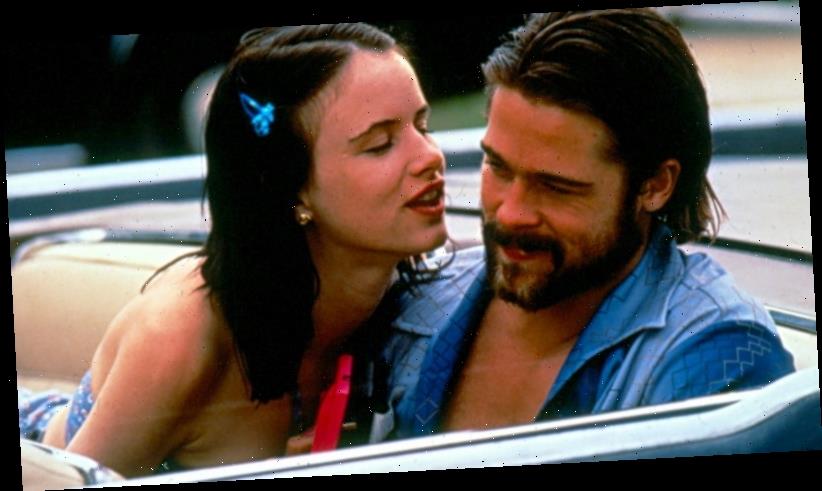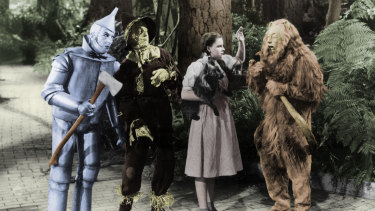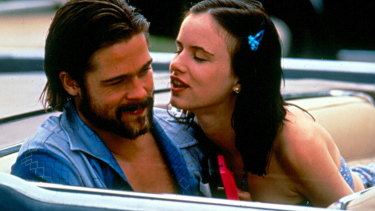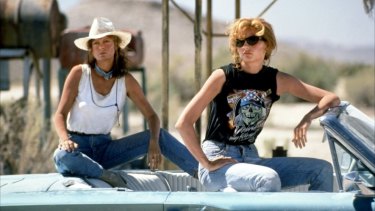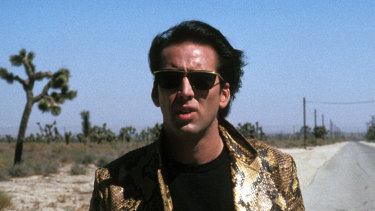The first road movie I ever saw was The Wizard of Oz. This may seem like an odd category, given the lack of cars, but it has more than enough of the key elements to make up for it: quirky characters, delusion, momentum, trouble, desire and a destination. Of course it ruined me, illustrating the inkling I had that my reality was lacking. Kid-me knew somewhere over the rainbow everyone thought I was funny and wanted to be my friend. Bluebirds flew and there was endless Milo and school was optional.
The lure of this – or any – somewhere was strong, like something pulling on my insides. Even when Dorothy’s destination was revealed to be a sham, I still hoped she could live in the Emerald City because Kansas looked dire. I was big on dreams. I felt that if you imagined something, it lived. Maybe you couldn’t pin it on a map, but it made you feel and so had to be real. Like Aristotle said, ‘‘What exists is somewhere for what does not exist is nowhere’’. (Or maybe like Bob Dylan said, ‘‘I’ll let you be in my dreams if I can be in yours’’.)
On the yellow brick road in The Wizard of Oz.
Our first family road trip was nothing like The Wizard of Oz. It was Mum and Dad and four kids in a HiAce. We were going north to Cairns and Cape Tribulation, and my only memories are photo memories. I was five. My baby brother travelled in a seat Dad fashioned from a desk drawer. I don’t remember music or singing or linked arms or flying monkeys or hot chip dinners or a glass-bottom boat or peeling continents of skin off my sunburnt shoulders, but some or all of these things happened.
In high school I forgot about cars and road trips. I was not one of those teenagers champing at the bit to get my driver’s licence. My reasons were financial. I was OK catching trains, and I had enough friends with cars. The dream destination then was Byron Bay or Coff’s Harbour or even the Gold Coast. White boys with dreadlocks. They were a kind of destination too. Schoolies wasn’t called Schoolies but a version of it happened. Young people gathered where rich kids had holiday houses to get wrecked and do regrettable things. There were no wristbands or ‘‘recharge zones’’, no vollies in fluoro vests shepherding drunk girls to safety. (I wish there had been.)
My memories of post-school summer, 1989, are also photo memories. An arrangement of tents. A tangle of teenagers. Flushed skin and bracelets made from beer can rings. We travelled in convoy to Sorrento, one group leading in a hired pink limo. (In my photo Trish emerges from the sunroof triumphant with a glass of champagne in hand.) We were there for a week but it felt like forever. Days were for sleeping. Nights were for drinking. If it was too hot to walk to the shops we’d hitch a ride from one of the old dudes who made it their business to supplement the Frankston-Portsea bus route.
That summer I hitchhiked, imagining myself as carefree, imagining myself in a movie. I even did it when I got back to suburbia (I wasn’t really OK with trains). I hitched right up until posters of two young people who never made it to Confest started appearing on telephone poles – later they were counted among Ivan Milat’s victims.
So you see, it’s not such a distance from The Wizard of Oz to Wolf Creek. A road trip can end one of two ways: like a dream or like a nightmare. I want to write about innocence, how it fits into the genre, how my road-adjacent adventures could only have happened when I was at an age where cautionary tales still came from the movies and not from my Facebook feed.
Brad Pitt and Juliette Lewis in Kalifornia.
In the 1990s I went all over America without getting off the couch. A wave of road movies rolled into my local video store as indie filmmaking had its moment. Wild at Heart, Guncrazy, Highway 61, Kalifornia, Roadside Prophets, Natural Born Killers, True Romance, Thelma and Louise – I loved them all. Locally, the wave came later but the vibe was the same: Kiss or Kill, True Love and Chaos, Doing Time for Patsy Cline. There was Priscilla, of course, but it was the lovers-on-the-run sub-genre that obsessed me, a formula Luc Sante distilled to ‘‘a boy, a girl, a car, and a gun’’.
Susan Sarandon and Geena Davis in Thelma and Louise.
‘‘Teach me how to kiss,’’ Keechie says to Bowie in Nicholas Ray’s 1948 noir They Live by Night. ‘‘I don’t know what most girls like.’’ Keechie and Bowie are social outcasts but they are also babes in the woods. Bowie, imprisoned as a teenager, escapes years later with two career crims who convince him to rob a bank to fund a lawyer to exonerate him of his initial crime. He meets Keechie, the daughter of an associate and the two fall in love. Bowie dreams of a future for them in Mexico: ‘‘We can live down there like a couple of real people.’’
In every lovers-on-the-run film there is a moment of grace, where the fugitives play-act at being part of ordinary society. For Keechie and Bowie it’s a park stroll/nightclub date. They don’t understand the way other people behave – Why kick a ball around? Why go changing partners all the time when you’re dancing? The best they can do is imitate normal, but something always happens, someone always notices, and before long they are cast out again into the cold, unfeeling world.
In Badlands, Terrence Malick reimagined Charles Starkweather and Caril Fugate’s 1958 murder spree, renaming the lovers Kit and Holly. Starkweather grew up poor and angry, bullied in school for having a speech impediment. By 19 he’d settled on a personal philosophy that he was outside the law and could do what he wanted. Caril Fugate was 14 and either along for the ride or being held hostage (maybe a little of both.) In the film, Holly is the deadpan narrator (“Kit was the most trigger-happy man I’d ever met”).
When Holly’s dad tries to break them up Kit sees no alternative than to kill him, and so it begins. Magical thinking and child-like ritual is part of the lovers’ survival strategy. When Kit and Holly have sex, Kit marks the ground with a rock to symbolise their union. Lying low by a river, they ‘‘play house’’ in a treehouse, mimicking gender roles and dancing badly to Mickey and Sylvia’s Love is Strange. Periodically, Kit pauses to record his reflections for posterity. There is no morality; there is only mythology.
Nicolas Cage as Sailor Ripley in Wild at Heart.
Sailor Ripley and Lula Pace Fortune, the fugitives of David Lynch’s Wild at Heart, have a similarly idiosyncratic way of seeing the world. (‘‘This is a snakeskin jacket! It’s a symbol of my individuality, and my belief in personal freedom.’’) Wild at Heart has all the hallmarks of fugitive-lovers films past. It also pays homage to The Wizard of Oz. Lula is haunted by witchy cackles – her mother plays both good witch and bad. In a moment of extreme stress she taps her red shoes together and wishes for home, but home is another somewhere, a place they’re running both to and from.
If Badlands ends with the nightmare of Kit facing the electric chair and Holly facing her dead family and prison time, Wild at Heart ends with the dream of Sailor running through traffic to be reunited with his ‘‘Peanut’’. The lovers embrace on the bonnet of Lula’s convertible while their son (who has only just met his father) smiles sunnily. Sailor sings Love Me Tender and Lula is demonstrably appreciative.
Maybe I will only ever road trip vicariously. Maybe I don’t like driving enough. It took me three attempts to get my driver’s licence. My first car, a 1966 Holden HR in hospital green, was a style choice, but I was always anxious driving it. As I drove my brain would loop images of car crashes and exploding engines, psycho killers lying in wait on the back bench seat. One day I went over a speed hump and one of the wheels came off. I sold the car for $200 and bought a pair of expensive sneakers. For a while after that I walked everywhere.
Source: Read Full Article
